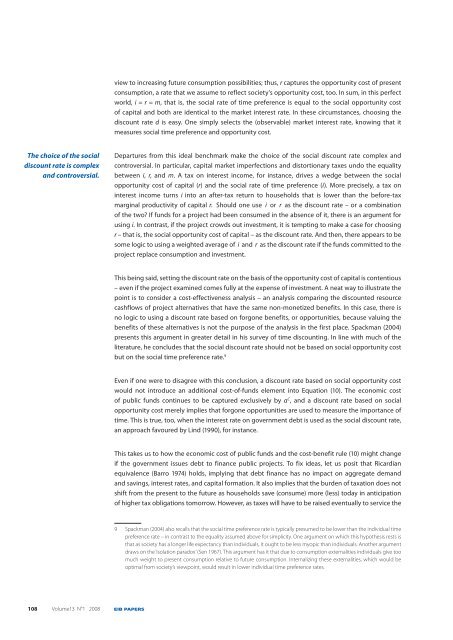EIB Papers Volume 13. n°1/2008 - European Investment Bank
EIB Papers Volume 13. n°1/2008 - European Investment Bank
EIB Papers Volume 13. n°1/2008 - European Investment Bank
You also want an ePaper? Increase the reach of your titles
YUMPU automatically turns print PDFs into web optimized ePapers that Google loves.
The choice of the social<br />
discount rate is complex<br />
and controversial.<br />
108 <strong>Volume</strong>13 N°1 <strong>2008</strong> <strong>EIB</strong> PAPERS<br />
view to increasing future consumption possibilities; thus, r captures the opportunity cost of present<br />
consumption, a rate that we assume to reflect society’s opportunity cost, too. In sum, in this perfect<br />
world, i = r = m, that is, the social rate of time preference is equal to the social opportunity cost<br />
of capital and both are identical to the market interest rate. In these circumstances, choosing the<br />
discount rate d is easy. One simply selects the (observable) market interest rate, knowing that it<br />
measures social time preference and opportunity cost.<br />
Departures from this ideal benchmark make the choice of the social discount rate complex and<br />
controversial. In particular, capital market imperfections and distortionary taxes undo the equality<br />
between i, r, and m. A tax on interest income, for instance, drives a wedge between the social<br />
opportunity cost of capital (r) and the social rate of time preference (i). More precisely, a tax on<br />
interest income turns i into an after-tax return to households that is lower than the before-tax<br />
marginal productivity of capital r. Should one use i or r as the discount rate – or a combination<br />
of the two? If funds for a project had been consumed in the absence of it, there is an argument for<br />
using i. In contrast, if the project crowds out investment, it is tempting to make a case for choosing<br />
r – that is, the social opportunity cost of capital – as the discount rate. And then, there appears to be<br />
some logic to using a weighted average of i and r as the discount rate if the funds committed to the<br />
project replace consumption and investment.<br />
This being said, setting the discount rate on the basis of the opportunity cost of capital is contentious<br />
– even if the project examined comes fully at the expense of investment. A neat way to illustrate the<br />
point is to consider a cost-effectiveness analysis – an analysis comparing the discounted resource<br />
cashflows of project alternatives that have the same non-monetized benefits. In this case, there is<br />
no logic to using a discount rate based on forgone benefits, or opportunities, because valuing the<br />
benefits of these alternatives is not the purpose of the analysis in the first place. Spackman (2004)<br />
presents this argument in greater detail in his survey of time discounting. In line with much of the<br />
literature, he concludes that the social discount rate should not be based on social opportunity cost<br />
but on the social time preference rate. 9<br />
Even if one were to disagree with this conclusion, a discount rate based on social opportunity cost<br />
would not introduce an additional cost-of-funds element into Equation (10). The economic cost<br />
of public funds continues to be captured exclusively by α C , and a discount rate based on social<br />
opportunity cost merely implies that forgone opportunities are used to measure the importance of<br />
time. This is true, too, when the interest rate on government debt is used as the social discount rate,<br />
an approach favoured by Lind (1990), for instance.<br />
This takes us to how the economic cost of public funds and the cost-benefit rule (10) might change<br />
if the government issues debt to finance public projects. To fix ideas, let us posit that Ricardian<br />
equivalence (Barro 1974) holds, implying that debt finance has no impact on aggregate demand<br />
and savings, interest rates, and capital formation. It also implies that the burden of taxation does not<br />
shift from the present to the future as households save (consume) more (less) today in anticipation<br />
of higher tax obligations tomorrow. However, as taxes will have to be raised eventually to service the<br />
9 Spackman (2004) also recalls that the social time preference rate is typically presumed to be lower than the individual time<br />
preference rate – in contrast to the equality assumed above for simplicity. One argument on which this hypothesis rests is<br />
that as society has a longer life expectancy than individuals, it ought to be less myopic than individuals. Another argument<br />
draws on the ‘isolation paradox’ (Sen 1967). This argument has it that due to consumption externalities individuals give too<br />
much weight to present consumption relative to future consumption. Internalizing these externalities, which would be<br />
optimal from society’s viewpoint, would result in lower individual time preference rates.

















